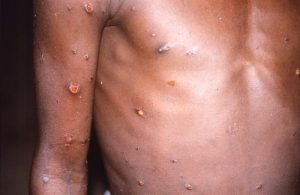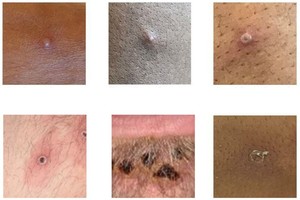All five who have tested positive in Kerala till now have come from the Gulf. None of the Monkeypox cases were detected at the airports.

A person who died of Monkeypox had tested positive for the virus in the UAE on 19 July and arrived in Thrissur on 21 July. He was not detected at the Kozhikode airport in Kerala (Twitter/Calicut International Airport)
In all the five cases of Monkeypox in Kerala till now, the infected passengers arrived from Gulf countries and passed undetected through airport surveillance.
One of them, who had arrived from the UAE, succumbed to the virus on 30 July. He had tested positive for the virus in the UAE on 19 July and arrived in Thrissur on 21 July without being detected at the Kozhikode airport in the state.
Airport surveillance for Monkeypox is turning out to be fruitless as there are many problems in detecting the virus.
According to Union Health Minister Dr Mansukh Mandaviya, health officials at the airports are performing only thermal scanning.
देश में #Monkeypox की स्थिति को लेकर राज्य सभा में मेरा विस्तृत उत्तर। pic.twitter.com/gIPU6KHBPW
— Dr Mansukh Mandaviya (@mansukhmandviya) August 2, 2022
“We have installed thermal scanners at the airport. If the international passengers are coming to the airport and they have fever, we will detect it,” Dr KP Hamzakoya, Airport Health Officer (APHO) at Kochi International Airport, told South First.
Thermal screening at the airport can only detect fever. Other symptoms like lesions or rashes cannot be detected with thermal screening.
Airport officials are now dependent on Air Suvidha Self Declaration Form, which has to be mandatorily filled by all international passengers arriving in India due to Covid, to detect Monkeypox.
“All international passengers are required to fill their details on Air Suvidha mandatorily due to Covid. Many Covid symptoms such as fever and cough are also symptoms of Monkeypox. If someone ticks the symptoms related to Monkeypox, we are checking them,” said Dr Hamzakoya.
“At the airport, if they have fever, we also look for symptoms like lesions, rashes, or pustules. If we find it, we inform the state surveillance team,” he added.
Health officials also pointed out that many passengers don’t provide the right details in the Air Suvidha portal due to the fear of getting isolated after their arrival.
“The biggest issue that we face at the airport is cooperation from the passengers. They do not cooperate with the help officials when we try to examine them,” Dr Ravi Patil, APHO at Bengaluru International Airport, told South First.
Health officials pointed out that as the Covid outbreak is still prevailing, it’s hard to differentiate the diseases.
“When they put out their details on Air Suvidha, for them it is Covid symptoms. But for us, we have to examine both Covid and Monkeypox,” said Dr Patil.
“During the surveillance, if we find someone having fever, we also have to do an RT-PCR test. If they test positive, we have to send them to hospital for further check-ups. If they test negative, we have to inform the surveillance team about them and then send them for 25 days of home isolation,” he added.
Dr Patil also pointed out that in the case of Monkeypox, symptoms such as lesions or rashes are on the body, and cannot always be detected at the airport.

Monkeypox lesions (Wikimedia Commons)
“We cannot see them, it’s hidden. And it will be insensitive to ask passengers to remove their clothes,” Dr Patil added.
Health officials are also facing a problem due to masking, a Covid protocol.
“Every person has to wear a mask at the airport and inside the cabin. Because of this, their faces are 60–70 percent covered. If they have lesions or rashes which mostly occur in the oral part and around the mouth, we cannot see them,” said Dr Hamzakoya.
The third case of Monkeypox in India was reported in Kerala on 22 July. The 35-year-old man returned from the UAE on 6 July and showed symptoms after two weeks.
Dr Hamzakoya pointed out that the incubation period of Monkeypox is 7–21 days. “When any passenger arrives at an airport during the incubation period, they don’t show Monkeypox symptoms. They are asymptomatic and no one can identify it,” he added.
Dr Chandrakant Lahariya, epidemiologist and infectious diseases specialist, said, “In the case of Monkeypox, detection of cases at airports is useful. But considering that confirmed cases have already been reported by around 80 countries and evidence emerging that virus might have been in circulation in multiple nations well before the start of this outbreak, the role of airport screening is limited.”
“Monkeypox is not Covid. That does not mean we should not focus on airport screening but we need not to be so paranoid,” he added.
As many of the cases are not being detected, airport health officials are mostly dependent on passengers to come to their desk and tell them about Monkeypox symptoms.

Examples of Monkeypox rashes (UK Health Security Agency)
“We have put signage everywhere at the airport, we are making announcements. But it is up to the passengers. They have to come and tell us about the symptoms, we cannot identify everyone at the airport,” Dr Hamzakoya said.
It should be mentioned that after the first case of Monkeypox was detected in Kerala on 14 July, a person from the state health department, who did not want to be named, had told South First that although the patient was obviously symptomatic when he arrived, he was not flagged by the airport surveillance system, immigration officials, or even security personnel.
Preventing Monkeypox spread requires active citizen participation and people should volunteer to disclose the symptoms and seek medical care, Dr Lahariya said.
“There are three things needed. From government, step up all possible public health measures. From citizens, do self-risk assessment and take preventive measures accordingly. The government needs to provide reliable and timely information, and citizens need to seek information from credible sources,” the epidemiologist added.
The Monkeypox virus spreads from person to person through close physical contact with infectious lesions, or by touching items like clothing, or through respiratory droplets produced by coughing or sneezing.

May 02, 2024

May 02, 2024

May 02, 2024

May 02, 2024

May 02, 2024

May 02, 2024